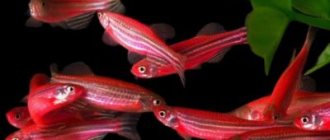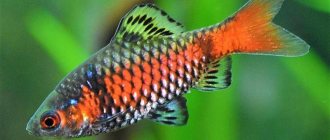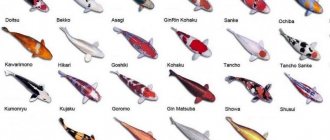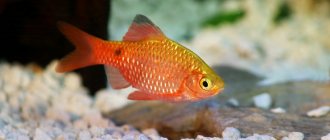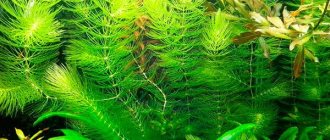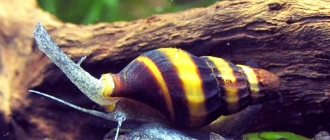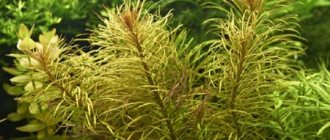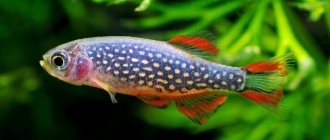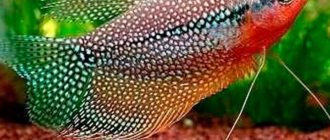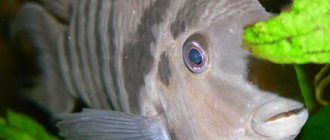Description
The Danio Rerio fish belongs to the carp family. In nature, they live in rivers and streams with large currents, so in the aquarium the flock will always be in close proximity to the air-generating filter.
They have an elongated flattened body, not exceeding 5 cm. Parallel stripes of different colors run along the sides. Depending on the time of year, adult Danios can change their color in the aquarium and become brighter.
Motherland
The birthplace of everyone's favorite Danio rerio is Asia. They can be found in large numbers in natural bodies of water stretching from Pakistan to India. Small populations of fish can also be found in the rivers of Bhutan, Bangladesh and Nepal.
Rerio was first described by Hamilton, who visited Asian countries in 1822 and became acquainted with this amazing representative of the local fauna.
Natural enemies of zebrafish
Photo: What a zebrafish looks like
The main enemies of zebrafish in nature have always been predatory fish. They are always ready to feast on these fish. Since zebrafish are very small in size, they are often swallowed several at a time. This is facilitated by their tendency to gather in schools, as well as their bright color - it is almost impossible not to notice zebrafish in the water column. The only hope is to move quickly. Often they manage to simply slip away from under the nose of the enemy.
Among the most dangerous enemies for this type of fish are: perches, catfish (exclusively in nature. In aquariums with catfish, zebrafish get along well), snakeheads. Among all these fish, only freshwater species pose a danger to zebrafish - they simply do not intersect with others. In addition to predatory fish, zebrafish also have bird enemies in nature. We are talking about herons and kingfishers. Since the fish likes to go into shallow water or even live in puddles in fields, many birds can easily feast on them.
Humans also pose a threat to zebrafish, but only during catching for the purpose of subsequent breeding. In artificial aquariums or ponds, they can live quite normally, only if predatory fish are not added to them. Otherwise, there are no special threats to them. In terms of the conditions themselves, only a sharp change in temperature can be dangerous. Cold water is absolutely unacceptable for zebrafish.
Kinds
To date, scientists have classified a large number of subspecies of Danio by color. Rerio, including transgenic fish (artificially bred), can have a variety of colors:
- Danio rerio pink;
- red;
- green Danio rerio;
- voile;
- glowing;
- albinos;
- yellow Danio Rerio
- etc.
And also today there are artificially bred species of Rerio, which have very bright fluorescent colors. Among the modified fish, the following stand out: blue, orange, pink, etc. As for the green glowing Danio, this color looks unnatural, so many aquarists do not recognize it. Despite the fact that these Danios are genetically modified, no negative consequences of human intervention in nature have been observed so far. That is why they continue to be very popular among both beginners and experienced aquarists.
Where to buy and what to look for?
When purchasing, you need to examine the skin of the fish and make sure that there are no signs of disease or mechanical damage on the body and fins.
Important! The fish may look too pale as a result of being frightened by the hand-to-hand transfer process.
After purchasing, you should place the zebrafish in a separate container to ensure its health.
The cost of fish depends on the rarity of the species . Common varieties of zebrafish cost from 35 rubles, fluorescent ones – from 45 rubles, and firefly zebrafish – from 137 rubles. per copy.
Care and maintenance
The aquarium fish Danio Rerio is very unpretentious, so it is easy to keep. In captivity, they are able to live in schools, so home aquariums should contain more than five representatives of this species. Life expectancy in good conditions is at least three years (maximum five).
The Danio Rerio fish should be placed in an aquarium whose length is significantly greater than its height, since it loves to chase its own kind. If you purchase a flock consisting of 10–20 individuals, then for a normal life a container with a volume of 30–70 liters will be enough for them. In the event that the population begins to actively increase, the owners will have to change the aquarium to a more spacious one. When arranging it, you should use floating plants or those planted in the ground, then they can always hide from annoying relatives.
It is recommended to keep the rerio at a temperature of 18–23 degrees; up to 30% of the water should be updated weekly. Due to the fact that such fish often jump out of aquariums, many owners cover them with lids. But at the same time they should leave a small gap through which air will flow.
Difficulty in content
These unpretentious and beautiful aquarium fish are great for beginners.
They are very easy to breed and the fry are not difficult to feed.
Since this is a schooling fish, you need to keep at least 5 of them in the aquarium, preferably more. They will get along with any peaceful and medium-sized fish.
Danio rerio eats any food you offer it. They tolerate very different water parameters very well and can live even without heating the water.
And yet, although they are very hardy, they should not be kept in extreme conditions.
By the way, don’t be surprised if you see that a school of zebrafish spends a lot of time near the filter, where the current in the aquarium is strongest.
They simply love the flow, as in nature they live in streams and rivers.
Feeding
Rerio prefer to swallow food from the surface of the water. But, if the granules begin to sink, they will happily swarm at the bottom of the aquarium. Many people prefer to use dry food, but we strongly recommend diluting your fish's diet with live food:
- small bloodworms;
- artemia;
- frozen tubifex.
Dry daphnia should first be rubbed with your fingers, due to which tiny fragments are formed that Rerio can swallow without any problems.
Compatibility with other fish
Thanks to its peaceful nature, Danio Rerio can be kept with various types of aquarium fish that do not show aggressiveness:
- guppy;
- platies;
- mollies;
- tetras;
- swordtails;
- gourami;
- boots;
- rasborami
- etc.
They should not be housed with the Denison Barb and others like it (astronotus, Koi carp, goldfish, discus fish, cichlids), as this predator will constantly injure their fins and tails. It is recommended to keep Rerio in flocks, from 10 to 15 pieces (minimum 5 individuals). In this case, a hierarchy will be observed between the fish, and the entire family will be able to more easily endure stressful situations. Despite the fact that Danios constantly chase each other, they do not show aggressive behavior with this behavior; it is simply their natural way of living in a pack.
Overview of varieties, examples of fish photos
As noted above, Danio rerio have a striped color and small transparent fins.
This is how they look in nature, but scientists and aquarists have developed new species of Danio rerio, which are more correctly called selection forms. Thanks to the work of breeders, the veiled Danio was born, with long transparent fins. Otherwise, it is no different from ordinary Rerio.
In addition to the shape of the fins, researchers and ordinary enthusiasts have worked to change the color of the Danio. One of the most famous varieties of Rerio is the Cherry Danio, also known as the Pink Danio, which has a cherry-pink body and silver-blue stripes. The fins also retain stripes; they often have a reddish or yellowish tint.
Another beautiful variety of Rerio is the Leopard Danio. These fish are distinguished by their spotted color, which explains their name. Their fins are usually transparent, with a repeating spotted pattern.
Leopard Danios with veil fins can also be found on sale.
As already noted, in 2003, Rerio became the first domestic genetically modified fish. Scientists introduced a fluorescence gene into their body: according to the plan, the individuals were supposed to glow in polluted water, acting as a kind of indicator.
Unfortunately, the researchers failed to achieve their goal, but aquarists were given unusually bright and attractive fish, which were called Glofish. There are several color options for Glofish:
- Red Fire Star;
- Green Electricity;
- Cosmic Blue;
- Purple Galaxy;
- Orange sun.
All of them are able to reproduce and pass on the glowing gene to their offspring. On the Internet you can often find information about other varieties of Danio rerio (for example, Pearl or Khopra), but these species belong to the general genus Danio and are not related to Rerio fish. For comparison, take a look at the photo of the fish.
Glofish
Pearl Danio
Reproduction and breeding
Even beginners can breed Danio at home. First of all, you need to learn to distinguish females from males. If you look closely at the body of the fish, you will notice that the males are more miniature in size, while the female’s abdomen is quite large and noticeable, especially when they are filled with caviar.
To determine whether female Danios are ready to spawn, you need to look at the bellies of the females, which should be equally wide in both the back and front of the body.
Female and male rerio
For spawning, it is recommended to use an aquarium with a volume of up to 10 liters, which is installed in a well-lit place. The bottom should be lined with plants, pressing them with pebbles. Next, water that has been standing for two days is poured into the container, which should cover the greens by approximately 6 cm. In the evening, fish are introduced into the aquarium, which adapt to the new conditions overnight, and in the morning they will begin to spawn.
Danio eggs are fertilized by the male's milk when they exit the female's body. One female can lay up to 450 eggs. The ripening process lasts for 2–5 days, depending on the conditions created. The eggs, which hang below the surface of the water for several days, can become food for their parents, so after the completion of spawning, males and females need to be removed. After a week, the Danio Rerio fry are ready to swim independently.
Step-by-step instructions for breeding Danios
Stage No. 1. Switch to high protein foods
Diet plays a key role in breeding Danio. Fish have evolved a simple biological mechanism - if there is a lot of food around, then they need to reproduce. Switch your fish to a diet consisting entirely of live or frozen daphnia, bloodworms, mosquito larvae and similar products. During a week of such a diet, some of the fish will become noticeably rounder - these will be females filled with caviar.
Stage No. 2. Separation of males and females
When it becomes clear where the females are and where the males are, they are temporarily separated by placing them in two separate tanks filled with water from the main aquarium. The tanks are equipped with a heater and an air-lift filter, and a lamp is installed outside. As the latter, it is permissible to use an ordinary table lamp, which will become a light source for two tanks at once. Registration is not required.
Separate housing lasts about a week (7–10 days). All this time, the fish must continue to be fed live food and do not forget to remove waste so that the water does not spoil.
If it is not difficult for you to determine the sex of the fish and you already know where the males are and where the females are, then step No. 1 can be skipped and the separation can be performed immediately. In this case, separation lasts approximately 2 weeks. The diet is similar - high in protein.
It is worth noting that experienced aquarists do not separate the fish, but immediately place them in a spawning aquarium (more on that below). However, beginners may miss the right moment of relocation, and the Danio will spawn in a common aquarium. In this case, saving the eggs will be problematic. Therefore, the separation option, although more troublesome, allows you to control the reproduction process.
Stage No. 3. Preparing the spawning aquarium
While the Danios are in separate tanks, it’s time to prepare a spawning aquarium. This can be almost any container from a three-liter jar to a basin. A volume of 20–40 liters is quite enough for a group of a couple of dozen fish.
Instead of soil, a layer of round balls (ceramic, glass, etc.) with a diameter of 1 cm or large pebbles of the same size, a special artificial spawning substrate or clusters of aquatic plants such as Java moss, Vesicularia dubi and others are placed on the bottom. The purpose of such a substrate is to protect the eggs from being eaten. Having fallen into the space between stones and plant sprouts/leaves, they become inaccessible to adult fish.
The spawning aquarium is partially filled with water from the main aquarium, which is then mixed with fresh soft water with neutral pH values in a ratio of 50% to 50%. The recommended height of the water column is no more than 10 cm. The water temperature should be 2–3 degrees lower than in tanks with fish. The set temperature is maintained using a heater - at this stage this is the only equipment in the spawning aquarium.
Stage No. 4. Spawning (reproduction) of Danio
7–10 days after separation, the fish are reunited again, but in a spawning aquarium.
Important! During spawning, there should be twice as many males as females. In the case when there are more females, only some of them are placed in the spawning aquarium
When the females spawn, they return to the main aquarium. The next day, the next group of females arrives to meet the males, waiting in a separate tank.
Typically, spawning occurs within 24 hours, the active phase begins closer to dawn, when dim morning light begins to penetrate the room. During spawning, males make light pokes on the abdomen of females, which causes them to spawn. If there are not enough males, the females will not be able to get rid of the eggs.
In the morning, carefully examine the substrate for the presence of small gray eggs. There are cases that fish fail to give birth to offspring on the first day, so they are left in the spawning aquarium for another day. If nothing happened on the second day, the fish are again divided into separate tanks and fed high-protein food for 3-4 days. Then they are connected together again.
Stage No. 5. The final stage - relocation of adult Danios
At the end of spawning, the fish are returned back to the general aquarium. Reservoirs where males and females were previously kept are emptied, equipment is removed and placed in storage.
Next, it is necessary to ensure the safety of the eggs and future offspring, which is described in detail in a separate article.
Diseases
The most common diseases of Danio rerio are:
- Tuberculosis. The infection is introduced along with soil, plants and sick fish. You can suspect an illness based on the following symptoms: lethargy, lack of appetite, loss of scales. Can be treated with Kanymitsin only at an early stage.
- Alkalosis. The disease occurs when fish are kept in an aquarium with an unbalanced acid-base balance of water. Rerio begins to behave restlessly and jumps out of the water. The color may fade, and the fish begins to rub against walls or pebbles.
- Bug-eyed. The reason is unsatisfactory water quality.
- Obesity. This problem occurs due to overfeeding.
- Growths on the body. The sick fish should be transplanted into a separate aquarium, where the water temperature is maintained at 28 degrees. To eliminate growths, it is recommended to take salt baths.
- Trichondiasis. Trichodina provokes the development of an infectious disease. The fish begins to rub against the walls of the aquarium, a dirty coating appears on the body, the color changes, and becomes paler.
Possible diseases
With proper care and maintenance, the “ladies' stocking” rarely gets sick. The first signs of illness are that a sick pet swims less and begins to stay away from the pack.
The fins are folded, the back bends, the fish appears stooped, the color fades, and with a prolonged illness, the stripes disappear and it becomes transparent. When parasites appear on the body, zebrafish begin to rub their abdomen on stones and grass. Some common diseases are listed below.
Bug-eyed
The disease develops due to increased acidity or excessive hardness of water.
Obesity
Occurs from overeating. This condition should not be allowed to occur in pets.
Trichodinosis
An infectious contagious disease caused by Trichodina ciliates. The pet begins to rub against stones and grass, and a dirty coating appears on the scales. The fish should be immediately placed in a separate jar and the temperature should gradually be raised to +30 °C. Use Tripaflovin or table salt as a medicine.
Alkalosis or alkaline disease
The cause of the disease is a shift in acid-base balance. The fish jump out of the water and scratch themselves on the rocks and plants.
Tuberculosis or mycobacteriosis
A dangerous infectious disease that is fatal. The causative agent is mycobacteria, which enter the aquarium from the external environment along with food, soil, and plants. Healthy fish become infected through sick ones. The individual becomes lethargic, eats poorly, stoops, and fins are destroyed. In severe stages, bulging eyes, bloating of the abdomen and loss of scales occur. Mycobacteriosis affects internal organs.
An accurate diagnosis can only be made by an experienced specialist through examination under a microscope. Sick pets are difficult to treat and more often die.
In the event of a mass exodus of fish, it was previously recommended to destroy all inhabitants (even snails and plants), replace the soil, and disinfect the aquarium and all equipment. Only very recently it became clear that mycobacteria do not manifest themselves when properly maintained.
Pets are affected by parasites when their immunity is weakened. Unfavorable water composition, toxic poisoning, stress, temperature fluctuations weaken the immune system.
Among the known drugs for the treatment of tuberculosis, Kanamycin is successfully used. Treatment is carried out in two ways:
- The medicine is added to water at the rate of 3-6 g per liter.
- Live food is soaked in the preparation and given to the fish. The duration of treatment is 12-14 days.
Growths on the body
This problem occurs quite rarely and when it occurs, it is necessary to transfer the fish from the general aquarium to a separate container for quarantine, where the water temperature is 28 °C, to use salt baths.
Bloating
Frisky fish have a tendency to bloat, this condition can easily be confused with overeating or caviar. Associated signals are inactivity, constant stay at the bottom, distancing from other individuals. There are many reasons for abdominal bloating; most often it is caused by infectious bacteria.
Metrodinazole, at the rate of 1 tablet per liter of water, will help save a sick pet. After 7 days the disease should subside. The convenience of this drug lies in the fact that the individual does not need to be removed, and other representatives of the aquatic world will not be harmed by prevention.
Bloating in zebrafish
Plistophorosis
This disease is characterized by the appearance of white spots on the body, which later become ulcers. The fish begins to lose weight, its fins take on a disheveled appearance, and begins to move at an angle of 40, 90 degrees. In addition to treatment, the aquarium is disinfected by first removing the soil and adding a 5% solution of hydrochloric acid or bleach.
Plistophorosis in zebrafish
For treatment, drugs are added directly to the feed. Add trichopolum at the rate of 5 mg per 1 liter of water, or erythrocycline at the rate of 50 mg per 1 liter. A solution of methylene blue is also suitable as an effective preparation - it will require 10 mg per 1 liter of water.
